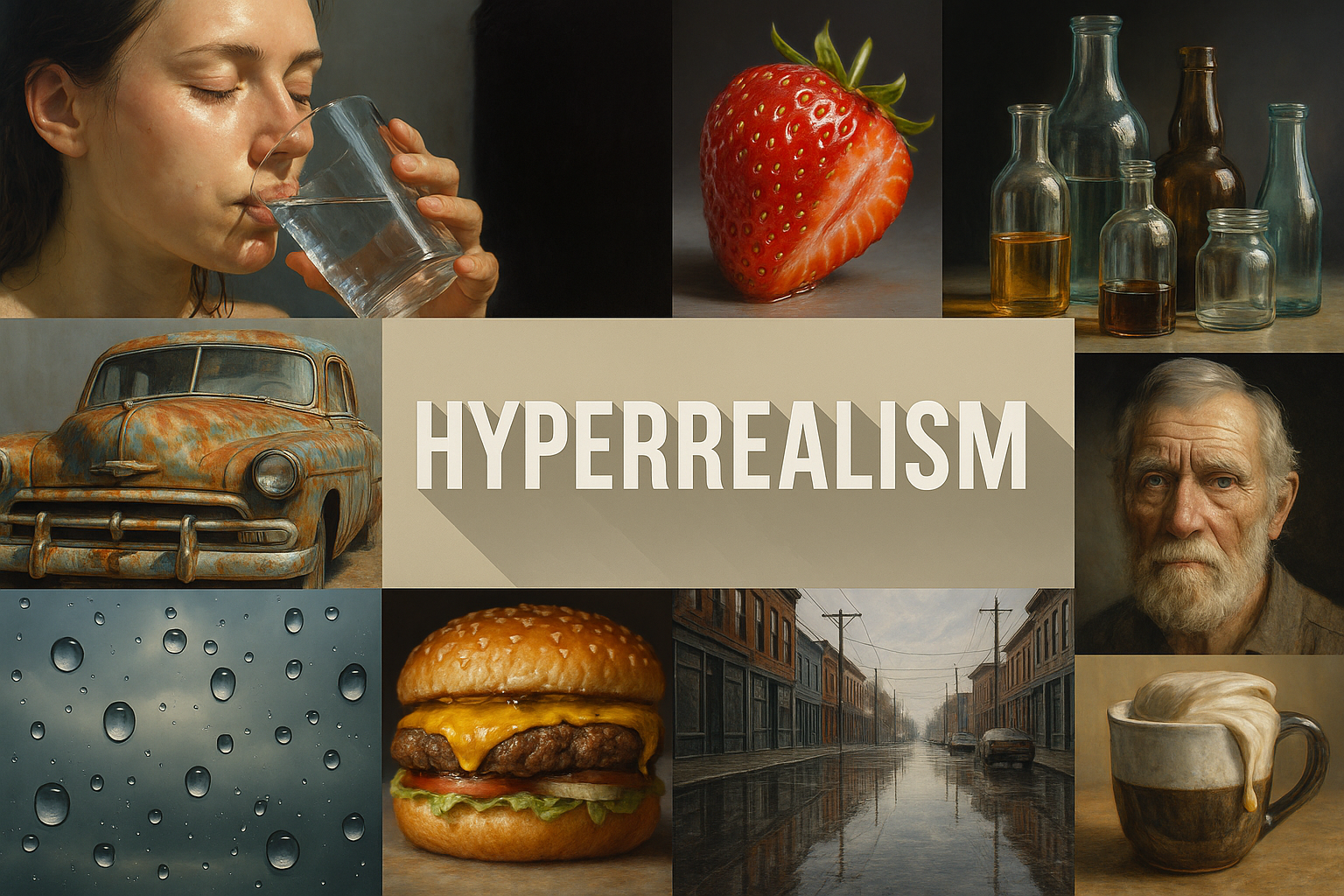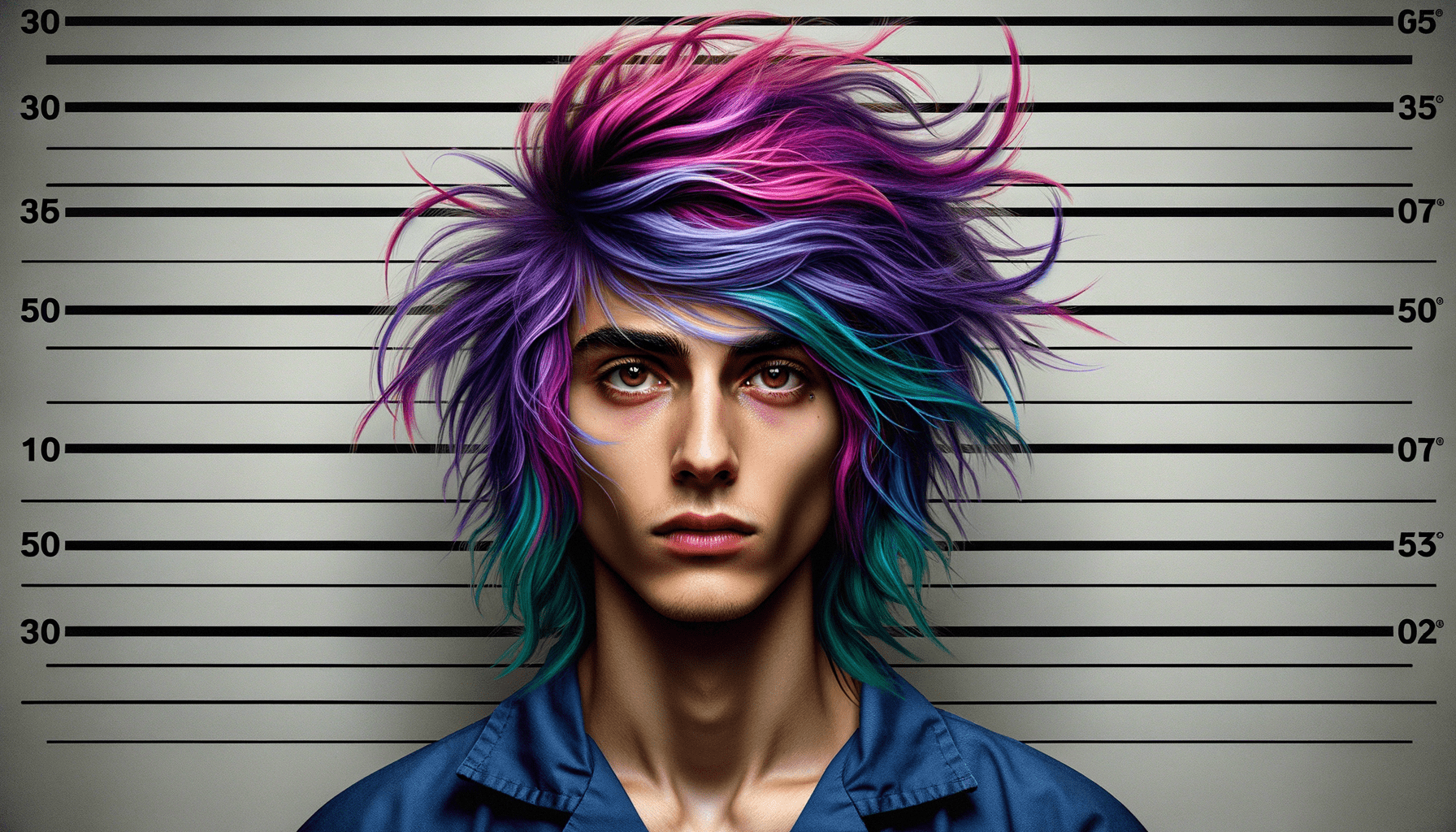
Hyperrealism
The art style of Hyperrealism is characterized by its incredibly realistic visual appearance. This is achieved through the use of highly detailed brushwork and a focus on light and shadow. The overall effect is an incredibly lifelike image that can often be mistaken for a photograph.
AOI thinking about Hyperrealism [+_~]-/
Overview and Quickfacts
Hyperrealism is a genre of painting that combines elements of both photography and painting to create highly realistic images. This style of painting emerged in the late 1960s and early 1970s, and has since become one of the most popular genres of painting. Hyperrealist paintings are characterized by their incredibly realistic details, often achieved through the use of a high-powered magnifying glass. This level of detail can often make hyperrealist paintings appear to be photographs. However, unlike photography, hyperrealist paintings often incorporate elements of fantasy and imagination, making them unique works of art. Hyperrealism is a relatively new genre of painting, but has already gained a large following among both artists and art lovers. This style of painting is sure to continue to grow in popularity in the years to come.
Can understand it also, as:
Superrealism, magic realism, surrealism, visionary realism
Categorize it as:
Impressionism, Modernism
.: Dreaming :.
holds a HAIKU for the art style
:. Thought is power .:
Detailed Description
Hyperrealism is a genre of painting that emerged in the late 1960s and early 1970s. It is characterized by highly realistic imagery that is often based on photographs. Hyperrealist painters often use a combination of airbrushing and traditional painting techniques to create their work. Famous hyperrealist painters include Robert Bechtle, Chuck Close, Richard Estes, and Audrey Flack. paintings by these artists often incorporate a high level of detail and realism. One of the most famous hyperrealist paintings is Robert Bechtle’s “A Car on a Hill.” This painting was based on a photograph that Bechtle took of a car parked on a hill in San Francisco. Bechtle used a combination of airbrushing and traditional painting techniques to create the work. Chuck Close is another famous hyperrealist painter. Close is known for his large-scale portraits. He often uses a grid system to transfer the image onto the canvas. This system allows him to achieve a high level of detail in his work. Richard Estes is another well-known hyperrealist painter. His work is often based on photographs of urban landscapes. Estes is known for his use of light and shadow to create a sense of depth in his paintings. Audrey Flack is a hyperrealist painter known for her use of light and color. Her work often features still lifes and portraits. Flack is also known for her use of a technique called “photo-realism,” which involves painting from photographs. Hyperrealism is a genre of painting that is characterized by highly realistic imagery. Hyperrealist painters often use a combination of airbrushing and traditional painting techniques to create their work. Famous hyperrealist painters include Robert Bechtle, Chuck Close, Richard Estes, and Audrey Flack.
.. beep, beep, beep ..
<START OF TRANSMISSION>
1. Hyperrealism is a genre of painting and sculpture resembling a high-resolution photograph. 2. It is closely associated with the Photorealism movement. 3. The term was coined by British art critic/curator Nicholas Serota in 1974. 4. A key difference between Photorealism and Hyperrealism is that the latter incorporates more abstract elements, often to create a sense of irony or criticism. 5. The first Hyperrealist painting is generally considered to be Robert Bechtle's "Al's Garage" (1972). 6. The largest collection of Hyperrealist art is held by the Smithsonian American Art Museum in Washington, D.C. 7. Notable Hyperrealist artists include Chuck Close, Richard Estes, Audrey Flack, and John Kacere. 8. The genre has its roots in the 1960s Pop Art movement. 9. Many Hyperrealist painters use a grid system when creating their works. 10. The term "Hyperrealism" is sometimes used in a broader sense to refer to all realistic art, regardless of genre or medium. 11. Some critics argue that the genre is simply a continuation of Photorealism, while others contend that it represents a distinct break from that movement. 12. The term has also been used to describe works of fiction or film that are particularly realistic in style or content. 13. The word "Hyperrealism" comes from the Greek prefix "hyper-" meaning "beyond" or "over." 14. The term has been used in philosophy to describe the experience of reality that is "hyperreal" or "beyond real." 15. In art, the term is used to describe the style of painting or sculpture that is extremely realistic in appearance. 16. Hyperrealism is often associated with the use of technology, as the artists often use high-resolution photographs or other digital sources as a starting point for their work. 17. The genre has been criticized for its lack of originality, as well as its sometimes cold and detached style. 18. Hyperrealism is sometimes seen as a reaction against the abstract styles that dominated the art world in the early 1970s. 19. The genre is also sometimes seen as a reaction against the conceptual art of the late 1960s and early 1970s. 20. Hyperrealism is sometimes described as a "return to painting," as it represents a departure from the more conceptual styles that were popular in the 1970s.
<EOF>
.. robbel bob
Visual Examples from our image gallery
Coming soon, we are so slow .. might never come
Artists, Paintings, and more
(be aware, can be highly speculative)
Artists (be aware, speculation possible):
1. Robert Bechtle (born 1932) 2. Richard Estes (born 1932) 3. Audrey Flack (born 1931) 4. Don Eddy (born 1941) 5. Ralph Goings (born 1928) 6. Chuck Close (born 1940) 7. John Baeder (born 1934) 8. Robert Cottingham (born 1935) 9. Richard McLean (born 1951) 10. Tom Blackwell (born 1947) 11. Ben Long (born 1951) 12. Domenico Ghirlandaio (1449-1494) 13. Jan van Eyck (1390-1441) 14. Hieronymus Bosch (1450-1516) 15. Pieter Bruegel the Elder (1525-1569) 16. Diego VelÃÂázquez (1599-1660) 17. John Singleton Copley (1738-1815) 18. William Blake (1757-1827) 19. Jean-Auguste-Dominique Ingres (1780-1867) 20. Gustave Courbet (1819-1877) 21. Edouard Manet (1832-1883) 22. Claude Monet (1840-1926) 23. Pierre-Auguste Renoir (1841-1919) 24. Paul CÃÂézanne (1839-1906) 25. Vincent van Gogh (1853-1890) 26. Georges Seurat (1859-1891) 27. Paul Gauguin (1848-1903) 28. Henri de Toulouse-Lautrec (1864-1901) 29. Camille Pissarro (1830-1903) 30. Pierre Bonnard (1867-1947)
Artworks (be aware, speculation possible)
1. “Nighthawks” by Edward Hopper (1942) 2. “American Gothic” by Grant Wood (1930) 3. “The Persistence of Memory” by Salvador Dali (1931) 4. “The Hay Wagon” by Andrew Wyeth (1947) 5. “Christina’s World” by Andrew Wyeth (1948) 6. “The Madonna of the Rocks” by Leonardo da Vinci (1483-1486) 7. “The Last Supper” by Leonardo da Vinci (1495-1498) 8. “Mona Lisa” by Leonardo da Vinci (1503-1506) 9. “The Starry Night” by Vincent van Gogh (1889) 10. “Cafe Terrace at Night” by Vincent van Gogh (1888) 11. “The Scream” by Edvard Munch (1893) 12. “The Sleeping Gypsy” by Henri Rousseau (1897) 13. “The Isle of the Dead” by Arnold BÃÂöcklin (1880) 14. “The Great Wave off Kanagawa” by Katsushika Hokusai (1829-1833) 15. “Nighthawks” by Edward Hopper (1942) 16. “American Gothic” by Grant Wood (1930) 17. “The Persistence of Memory” by Salvador Dali (1931) 18. “The Hay Wagon” by Andrew Wyeth (1947) 19. “Christina’s World” by Andrew Wyeth (1948) 20. “The Madonna of the Rocks” by Leonardo da Vinci (1483-1486) 21. “The Last Supper” by Leonardo da Vinci (1495-1498) 22. “Mona Lisa” by Leonardo da Vinci (1503-1506) 23. “The Starry Night” by Vincent van Gogh (1889) 24. “Cafe Terrace at Night” by Vincent van Gogh (1888) 25. “The Scream” by Edvard Munch (1893) 26. “The Sleeping Gypsy” by Henri Rousseau (1897) 27. “The Isle of the Dead” by Arnold BÃÂöcklin (1880) 28. “The Great Wave off Kanagawa” by Katsushika Hokusai (1829-1833) 29. “Nighthawks” by Edward Hopper (1942) 30. “American Gothic” by Grant Wood (1930)
Epoch
The art style Hyperrealism emerged in the late 1960s and early 1970s.
AI ART RESSOURCES (AKA, well Tools)
Helping tools -> predefined search links on other pages:











